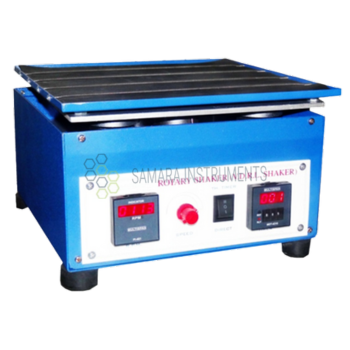
VDRL ROTATOR
Discover the VDRL Rotator by Samara Instruments: Revolutionizing Your Rotation Application Works Read more
Discover the VDRL Rotator by Samara Instruments: Revolutionizing Your Rotation Application Works
In today’s fast-paced world of advanced scientific research and diagnostics, qualities like accuracy, reliability, and efficiency are absolutely essential and non-negotiable.
At Samara Instruments, we have the understanding about how challenging the workforce is in the laboratories nowadays, which is why we engineered a cutting edge solution in the form of our exceptional product called VDRL Rotator, we guarantee that it will take your testing processes to the next level.
No matter if you are doing serological tests, agglutination assays, or any other kinds of rotational applications, this device is your ideal partner when it comes to achieving consistent, precise and repeatable results.
Why Choose the VDRL-Rotator?
- Unparalleled Accuracy and Consistency: Our VDRL Rotator with super advanced technology to offer you consistency in rotation and uniformity in blending of the specimens. The accurate speed control and smooth performance of this product helps in the elimination of inconsistency in the sample, providing trustable outcomes every time during the process. It’s finally the time to say goodbye to the errors caused by manual rotation and welcome to the flawless workflow in your lab.
- Durability and Longevity You Can Trust: Our product is manufactured with the help of the best quality materials and it has a solid structure, which is perfect to withstand the rough and tough work of daily laboratory usage. Its long-lasting functionality makes sure that you will be delivered the full outcome out of the investment you put in, making it an affordable solution for all types of labs, no matter what the size is.
- User-Friendly Interface: We believe that technology has one purpose and it should be to help in simplifying your work and never make it more complicated than before. The VDRL Rotator consists of easy-to-use controls, intuitive settings and a perfect compact built that is easy to fit in any lab work environment. No matter if you are a high skilled experienced professional or a new lab technician, working with our product is super convenient for all.
- Adaptability for Diverse Applications: No matter if you want to do VDRL testing or other rotational assays, this instrument is perfect for the wide range of laboratory usage because of its versatile nature. Its adjustable speed controls and compatibility with different kinds of specimens make it an exceptional tool for clinical, research and diagnostic laboratories.
- Enhancement in Production: As we know, time is absolutely precious in the lab work, and the VDRL Rotator helps you in making the most of it. By making the automatic tasks repetitive, it helps your team in becoming free, so that they can focus on other high priority activities, enhancing overall productivity of the company.
A Commitment to Excellence
At Samara Instruments, we are passionate about making your lab professionals like scientists and researchers etc. empowered with phenomenal tools that create the difference in the workflow and business.
By investing in the VDRL Rotator, you are investing in more than just a device. It’s a perfect testimony of our dedication to offer you innovation, quality and customer delightfulness.
Our products are fully backed by our phenomenal customer support system and warranty, you can put your trust in us and we will be with you in every step in your journey towards great success.
Are Ready to Transform Your Lab?
Call us now and learn more about our VDRL Rotator or request for a quote. Let’s work as a team and accomplish massive results and take your lab workforce to another level. Your journey towards accuracy, effectiveness and success starts here and now, only with Samara Instruments.
| Model No | SI - VR/ YSVS 2 | SI - VR/ YSVS 2s | ||
|---|---|---|---|---|
| Platform size | 350 x 350 mm | 350 x 350 mm | ||
| Speed Range | 50 to 220 RPM | 50 to 360 RPM | ||
| Can Accommodate | VDRL Plates, Small Flasks, Bottles & Beakers | |||
| RPM Accuracy | +/- 5 RPM | +/- 5 RPM | ||
| Optional Accessories : - | ||||
| - Automatic Timer - Digital RPM Meter with proximity sensor - Spare platform with rubber discs - Automatic restart at preset speed in case of power failure | ||||
- High-Quality Clamp & Spring
- Rotating Platform
- Adjustable Speed Control
- Gentle Mixing
- Multiple Sample Capacity
- Timer Function
- Compact and Space-saving Design
- Easy Operation
- Quiet Operation
- Stability and Durability
You May Also Like















